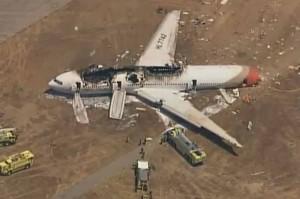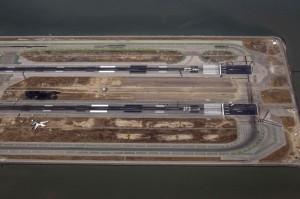Yesterday’s crash of Asiana Airlines Boeing 777 is not too difficult to understand, now that certain data has been revealed. Most pilots will explain this as a poor landing by these pilots at San Francisco International Airport. As is true of all such accidents, the cause is a combination of events the led to the crash. Actual video of the crash can be found on the CNN website.
We are told that the airplane was lower and slower than it should have been at the time of the crash. Every airplane has a target airspeed at which it should be flown during each portion of the final approach to landing. For the Boeing 777, the target airspeed was 137 knots, and this airplane had been allowed to get slower by the pilot flying. The pilot not flying usually monitors altitude and airspeed and has the responsibility in most commercial operations to immediately alert the flying pilot if there is a problem. The pilot flying has the responsibility to maintain altitude and airspeed during a visual approach on a clear day. That was the situation when the crash occurred.
The pilot flying has to gauge the descent such that the airplane arrives at the runway threshold (the start of the runway) high enough that the airplane will touch down about 500-1000 feet down from this point. Most airports have a lighting system to assist the pilot in judging altitudes during the approach to landing. Two contributing factors to this accident were the facts that this landing assist lighting system was not operating due to construction at the airport, and the runway location creates an optical illusion that alters the pilots perception of actual altitude. This runway extends into San Francisco Bay.  This flat water on the approach to landing creates an optical illusion that can lead to a lower approach than is required. This was the pilots first time at San Francisco International, and it is probable that this optical illusion played a role in the airplane being too low. Although the pilot flying had only 40-50 hours in this aircraft prior to this crash, he should have been trained well enough to have a correct sight picture for the approach and landing. Finally, it is said that the pilot tried to abort the landing but was unable to do so. The reason for this was twofold. As the airplane was too slow, when he raised the nose, the airplane did not have enough airspeed to avoid stalling (the wing stops producing lift) nor was there enough time or altitude for the engines to produce sufficient power to arrest the descent of the airplane and the tail struck the runway and came off the airplane as a result of the nose up attitude of the airplane.
This flat water on the approach to landing creates an optical illusion that can lead to a lower approach than is required. This was the pilots first time at San Francisco International, and it is probable that this optical illusion played a role in the airplane being too low. Although the pilot flying had only 40-50 hours in this aircraft prior to this crash, he should have been trained well enough to have a correct sight picture for the approach and landing. Finally, it is said that the pilot tried to abort the landing but was unable to do so. The reason for this was twofold. As the airplane was too slow, when he raised the nose, the airplane did not have enough airspeed to avoid stalling (the wing stops producing lift) nor was there enough time or altitude for the engines to produce sufficient power to arrest the descent of the airplane and the tail struck the runway and came off the airplane as a result of the nose up attitude of the airplane.
As has been found to be true in most aircraft accidents, it is not just one factor that leads to a crash, it is a combination of events that results in the accident. The reports from the examination of the cockpit data recorder reveals that the airplane and its systems were functioning normally. The voice recorder will add information to reveal whether the pilot flying, and the pilot not flying were also functioning normally.
We should also be complimentary to the crew of this flight for doing their job and clearing the fuselage of passengers in a very short time, thus avoiding deaths due to fire in this aircraft crash. The emergency response crew also did good work in controlling the fire that resulted from the crash.
(The author is a commercial instrument rated pilot with 2000 hours of flight experience in single engine aircraft.)
